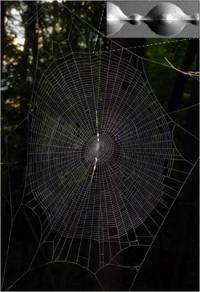Spider silk glue inspires next-generation technology

(PhysOrg.com) -- Water affects orb spider web glue differently than cobweb glue. Orb web glue reacts to humidity, but cobweb glue resists it. These findings by a University of Akron research team inspire the development of new materials according to how they respond to stimuli.
This newly released research by Vasav Sahni, a UA polymer science graduate student; Todd Blackledge, the Leuchtag Endowed Chair and associate professor of biology and integrated bioscience; and Ali Dhinojwala, UA Department of Polymer Science chair and H. A. Morton Professor of Polymer Science, is published in the July 21, 2011, issue of Scientific Reports.
Humidity triggers adaptability
The research shows that the sticky glue that coats the silk threads orb-weaving spiders spin has a different structure, property makeup and response to humidity than glues produced by their evolutionary descendants, cobweb-weaving spiders. The cobweb spider's gumfoot glue acts as a viscoelastic liquid that is resistant to changes in humidity, consequently maintaining constant elasticity and adhesion.
Orb weavers, on the other hand, produce glue that acts like a viscoelastic solid. Highly humidity-sensitive, this glue expands in magnitude and demonstrates a monotonous increase in elasticity under increased humidity. The glue also displays a decrease in surface adhesion that results in optimal adhesion at intermediate humidity.
"We suggest that observed differences are due to different 'tackifiers' used in these systems," says Sahni. "These results will inspire future efforts in fabricating stimuli-resistant and stimuli-sensitive materials."
Evolutionary changes advance science
Behaviors of natural biomaterials, such as spider glue responses to humidity, provide templates for developing smart materials and devices that change dimension, property makeup and function in response to external stimuli, according to Vasav. He adds that evolutionary changes provide powerful tools to advance biomimetic research toward understanding key elements that control biomaterials' environmental responsiveness or resistance to stimuli.
The researchers probed individual glue droplets to reach their findings. They explain in their paper that "both orb web and cobweb spiders depend on viscid glue droplets for their silk to adhere to insect prey. Both types of spiders use the same sets of glands to produce the adhesive." However, similarities between the two, for the most part, end there.
The opposite reactions of the two bioadhesives to humidity are as dramatic as the complexity of processes contributing to these phenomena, the scientists explain in their research. Consequently, the researchers designed a polymer model of the glue droplet, dissolved in water, to simplify and better understand the underlying mechanisms that cause the orb web spiders' silk adhesive to react to humidity.
Reactions of spider glue, pine cones, bird feathers, and several other natural materials to different stimuli provide scientists inspiration for developing next-generation materials based on biomimetic research, or research that mimics nature.
More information: See "Changes in the Adhesion Properties of Spider Aggregate Glue During the Evolution of Cobwebs."
Provided by University of Akron




















